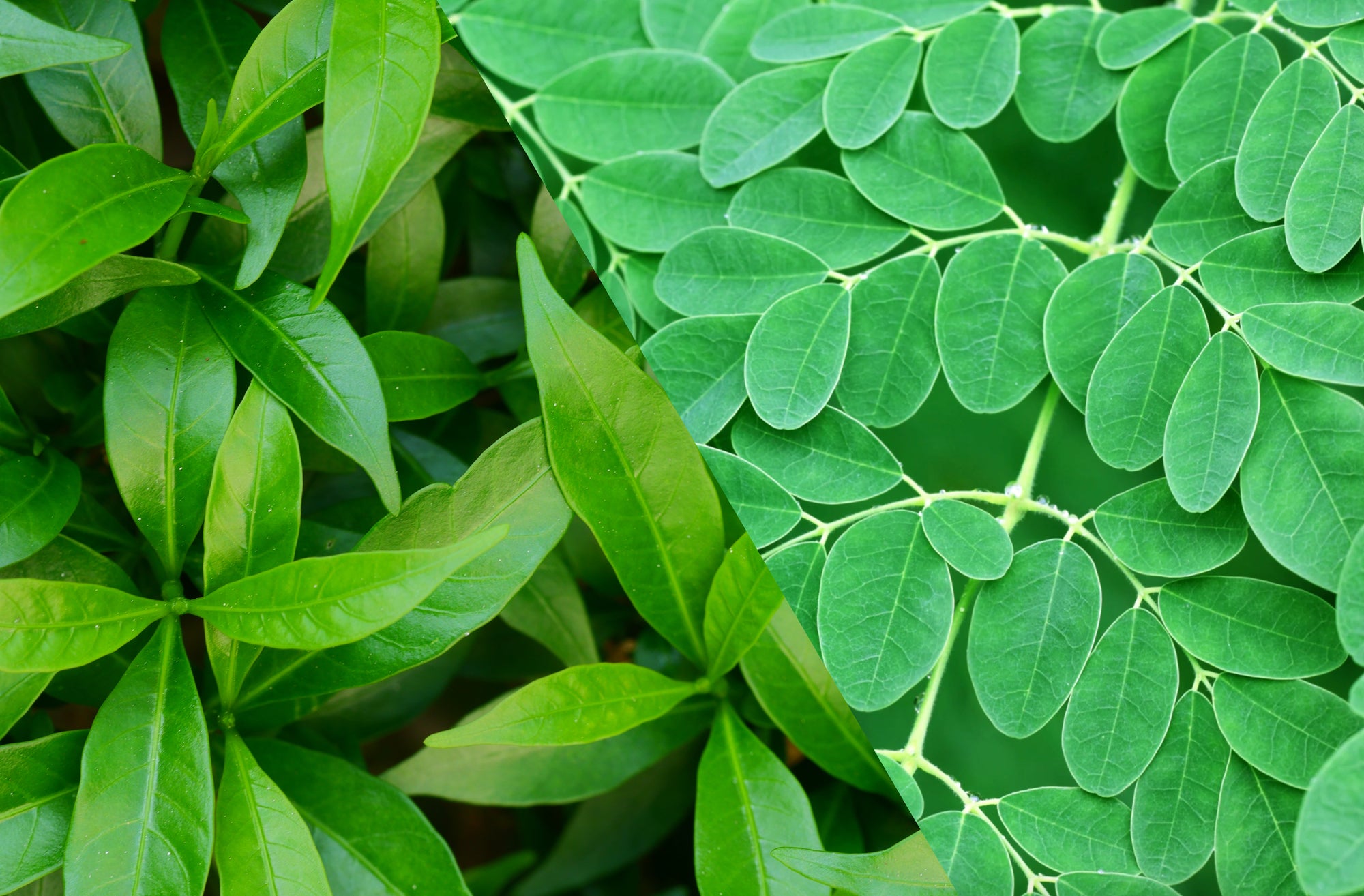
They’re both green. They’re both finding their way into lattes and green smoothies everywhere. Both matcha and moringa might seem like new health trends, but the truth is, these botanicals have been in use for centuries in traditional practices and in holistic medicine.
The team at JOYÀ doesn’t want you to be left in the dark. We’ll tell you everything you need to know about these two ingredients, including how they are alike and how they differ. We’ll also let you in on their incredible health benefits and share delicious ideas for adding them to your daily routine. Once you’re done, you won’t feel nearly as green to the game.
What Is Matcha?

You’re probably most familiar with matcha. Gwenyth Paltrow might have made matcha lattes popular with her 2015 Instagram post, but the use of matcha dates back to the 1100s, when it was used by Buddhist monks to help improve focus during meditation.
Now, you can get that same focus without devoting your life to silence and personal sacrifice.
Where Does Matcha Come From?
Matcha is a type of green tea and like all varieties of tea (green, black, oolong, white) comes from the tea plant, known formally as Camellia sinensis. However, the tea leaves used to make matcha are grown in the shade so that the plant-based compounds inside them can’t be leached out from the sun.
Unlike regular green tea, where the leaves are steeped in hot water and then discarded, with matcha, the tea leaves are ground up into a very fine powder and then dissolved in water, which means that with matcha powder, you’re consuming every part of the tea leaf (including all the plant phenols, antioxidants, vitamins, nutrients, flavonoids, and fibers).

What Does Matcha Taste Like?
Matcha itself has an earthy, grassy, vegetal taste. In Japanese culture, the savory flavor is called umami, which means “essence of deliciousness.” Higher quality, ceremonial grade matcha will have a subtle sweetness, while lower quality culinary grade matcha will be more bitter. Matcha lattes or matcha teas may have added sweeteners to counter the bitterness when lower quality matcha powder is used.
How Can You Use Matcha?
You can use matcha to help support a calm sense of alertness and cognitive ability. It’s also traditionally used to help detox and tonify the blood, due to its high chlorophyll content.
- Calm alertness. If you notice more and more of your peers swapping their morning coffee for a morning matcha, there’s a good reason. Matcha contains two important compounds, caffeine and L-theanine. While caffeine acts on the nervous system as a stimulant, L-theanine (an amino acid found almost exclusively in tea leaves) has a calming effect on nerves while simultaneously activating alpha brain waves, which promote better focus.
The result? You get all the focus and heightened awareness, with none of those pesky caffeine jitters or accompanying midday crash.
- Antioxidants. Are you anti-aging? If so, you already know about antioxidants. If not, time for school. Antioxidants are compounds that help protect your cells against free radical damage, also known as oxidative stress.
Free radicals can damage your cells, and that damage can be replicated to new cells when they proliferate. This type of damage can cause premature aging on your skin, and in bodily systems.
If it’s a nutrient-rich functional food you want, check out JOYÀ’s Focus Matcha Superblend. This chef-crafted, expertly-formulated high-quality powder is the perfect way to add matcha to your day. Whether you use it to make a delicious matcha green tea, or add it to your choice of milk for a matcha latte, you’ll get all the benefits along with complementary herbs like stress-fighting ashwagandha, pine pollen, lion’s mane mushroom, and moringa.
Speaking of which, let’s get acquainted with that other green powder.
What Is Moringa?

Another green powder that’s making waves across social media and green smoothie stands is moringa. Moringa is a nutrient-dense superfood, and has also been used in traditional Ayurvedic medicine for thousands of years to treat illness and support overall wellness.
Where Does Moringa Come From?
Moringa is derived from the moringa tree, also called moringa oleifera. It’s sometimes referred to as the drumstick tree, or the miracle tree. Native to the sub-Himalayan mountains of northern India, almost every part of the tree can be used. At JOYÀ, we use moringa leaf powder in our products.

What Does Moringa Taste Like?
It’s safe to say moringa, like matcha, is an acquired taste. Moringa has an earthy essence but with a slight spirulina (read: algae) flavor. Lower quality moringa is notably bitter, and is almost always used with some kind of added sweetener.
What Are the Health Benefits of Moringa?
Moringa powder has some pretty impressive benefits. On top of being rich in nutrients, it’s also loaded with antioxidants and offers neuroprotective properties.
- Nutrient profile. Moringa contains so many nutrients that it’s been considered one of the foods that could help alleviate malnutrition in underdeveloped countries. It contains all nine essential amino acids, making it a complete protein. It also has a high amount of iron, calcium, vitamin C, potassium, vitamin E, and more vitamin A than carrots.
- Moringa has an impressive amount of antioxidants, helping you further protect your cells against oxidative stress.
- As for its neuroprotective benefits, moringa leaf extract (MLE) has been found in early studies to protect against brain injury when blood flow to the brain is impaired.
While the benefits might make you reconsider a bitter cup of moringa tea, you don’t have to choke it down in the name of good health. Instead, you can find pure, high quality moringa right inside JOYÀ’s Focus Matcha Superblend. All the benefits of moringa, none of the bitter taste. Plus, you’ll also be treating yourself to matcha at the same time.
Do Matcha and Moringa Pair Well?
Adding more matcha and moringa to your morning is a good idea. Not only do the earthy flavors complement each other, they also work together synergistically to deliver even more benefits than when consumed alone.
In fact, pairing matcha and moringa in one superfood powder (like ours) can help you get neuroprotective benefits like better cognition and healthy memory function while also increasing your capacity to focus and enjoy heightened productivity. Not to mention, you’ll be supercharging your antioxidant load by pairing both together in one fell swoop.

What Are the Main Differences Between Matcha and Moringa?
Despite their similarities in color and use, there are some key differences when comparing moringa vs matcha that are important to highlight.
Overall Nature
Matcha is derived from tea leaves, making any form of it a tea-based powder. Moringa, however, is an herb. While they are both plant-based and have some overlapping benefits and nutritional value, their very nature separates them into two different categories.
Nutrient Profiles
In terms of nutrients, moringa has more fiber, protein, vitamins, and minerals. But when it comes to antioxidants, matcha is the clear winner, containing more EGCG, a powerful antioxidant which moringa does not contain.
Caffeine
Because matcha is a form of green tea, it does contain caffeine. Matcha powder contains between 18.9 and 44.4 mg per gram, although the final caffeine content can depend on how the matcha is grown, which varieties you’re using, and how much matcha powder is used (the average matcha drink contains 1-2 grams of matcha). Although matcha does contain caffeine, because it is paired with L-theanine, it’s said to have a calmer effect on the system than coffee.
Moringa is naturally caffeine-free, so if you’re trying to cut down on your caffeine intake, a good solution would be to try substituting your daily coffee with matcha and then transitioning down to moringa if you want even less.
Flavor
In terms of flavor, most people will likely prefer matcha. However, when you combine both ingredients in one superpowder, like our Focus Matcha Superblend, you’ll get a delicious flavor that’s elevated with vanilla and cinnamon for a superfood matcha latte or perfect compliment to your favorite smoothie.
If you’d prefer to chew your matcha and munch your moringa, give these easy to make pancakes a try.
How to Get The Most Benefits
Like most any medicinal herb, consistency is key. If you don’t take matcha or moringa consistently, you won’t be able to appreciate all of the benefits. That’s why JOYÀ exists. We provide flavor-focused, functional food powders that you’ll actually want to make a part of your day.
Your first order of business? Uncovering all the many ways you can use them. From smoothies to pancakes, lattes to overnight oats, you’ll have no problem getting a scoop into your daily routine. For more inspiration, check our blog regularly.
The Bottom Line
The new green powder on the block isn’t matcha or moringa, it’s JOYÀ’s Focus Matcha Superblend. Matcha and moringa have been trusted for years to support health and wellness, and the western world is finally catching up.
Find ways to support your focus, amp up your antioxidants, and feel more balanced each day. JOYÀ makes it easy for you to get the nutrition you want.

